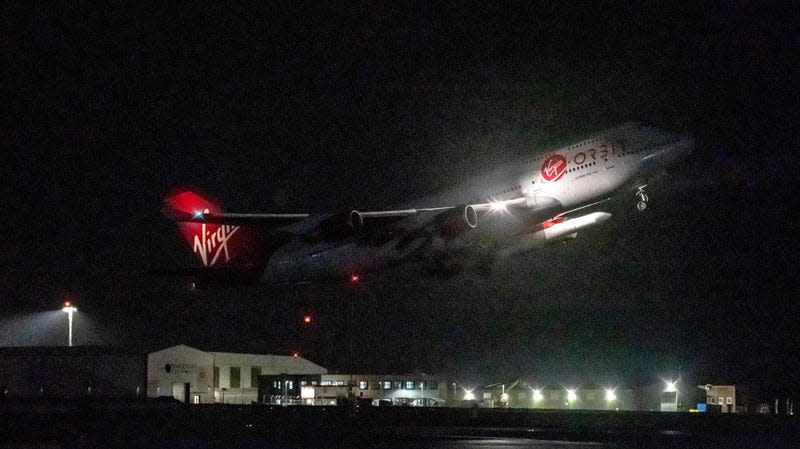Virgin Orbit's Failed Rocket Seen Crashing Back to Earth in Fiery Video

Virgin Orbit’s Cosmic Girl, carrying the LauncherOne rocket, taking off from the UK’s Spaceport Cornwall.
After failing to reach orbit and deliver seven payloads on board, Virgin Orbit’s LauncherOne rocket fell back to Earth towards its fiery doom. The rocket’s hellish descent was captured on video, revealing the unfortunate journey back from space.
Ramón López, an observer at the Spanish Meteor Network, caught the rocket reentering Earth’s atmosphere from Lanzarote, one of the Canary Islands off the west coast of Africa. He released the footage on YouTube, as well as on Twitter.
Read more
Reentrada Launcher One 09-01-2023
The video shows the LauncherOne’s second stage crashing back to Earth. “As it is doing so, friction with the atmosphere causes it to fragment, heat up and burn up, creating a slow moving fireball in the sky,” Marco Langbroek, an astrodynamics lecturer at Delft Technical University in the Netherlands, told Gizmodo in an email. “The rocket stage at that time still carried the payloads attached to it—they burned up along with the rocket stage.”
Langbroek identified the fiery object in the video as LauncherOne based on the time the video was captured, its geographic location, the viewing direction as seen from Lanzarote, and the direction of movement of the object. “The very slow apparent speed in the sky, long duration, and general looks of the fireball are also consistent with the reentry of an artificial object into the upper atmosphere,” he added.
Virgin Orbit’s modified Boeing aircraft, named Cosmic Girl, took off on Monday at 5:02 p.m. ET from the Spaceport Cornwall in England carrying the LauncherOne booster rocket tucked beneath its left wing. The mission was supposed to mark the first orbital launch from British soil, opening up new avenues for the space industry in the United Kingdom.
However, LauncherOne experienced an anomaly during the firing of its second stage engine and it was unable to reach orbit. “The upper stage did not attain the speed necessary to bring itself and its payloads in an orbit around Earth,” Langbroek said. “Although it did briefly reach space, it then fell back to Earth again due to this insufficient speed, on a suborbital ballistic trajectory.”
The mission, titled “Start Me Up,” carried satellites for seven commercial and government customers, including two cubesats for the U.K.’s Ministry of Defense, the AMAN Earth observing satellite from Oman, and Stork-6, the sixth satellite that was to be included in Poland’s Earth-observing cubesat constellation.
The satellites all suffered the same fate, burning up along with the rocket during reentry. It was a disappointing end to a highly-anticipated mission, which was meant to usher in a new era for the European space industry. Virgin Orbit and the U.K. Space Agency have launched an investigation to determine the cause of the rocket’s anomaly.
“We will work tirelessly to understand the nature of the failure, make corrective actions, and return to orbit as soon as we have completed a full investigation and mission assurance process,” Dan Hart, Virgin Orbit CEO, said in a statement. Following the mission failure, Virgin Orbit’s stock suffered a major blow, falling by about 22% in premarket trading on Tuesday morning, NBC reported. The company’s financial situation was already looking a little bleak, with Virgin Orbit reporting a net loss of $139.5 million through September 30, 2022, Ars Technica reported based on the company’s quarterly earnings.
“We will work closely with Virgin Orbit as they investigate what caused the anomaly in the coming days and weeks,” Matt Archer, director of commercial spaceflight at the U.K. Space Agency, said in a statement posted to Twitter.
Despite the recent setback, the U.K. still seems determined to establish its launch capability from British soil. “Despite this, the project has succeeded in creating a horizontal launch capability at Spaceport Cornwall, and we remain committed to becoming the leading provider of commercial small satellite launch in Europe by 2030, with vertical launches planned from Scotland,” Archer said. With LauncherOne grounded for now, the U.K. may look to other companies to get its orbital launches off the ground and to orbit.
More: Europe Has Few Options to Reach Space After Vega-C Rocket Crash
More from Gizmodo
Sign up for Gizmodo's Newsletter. For the latest news, Facebook, Twitter and Instagram.

